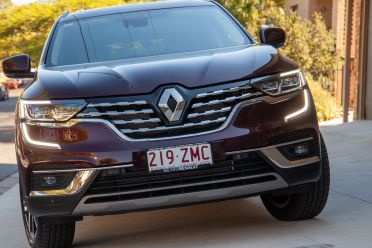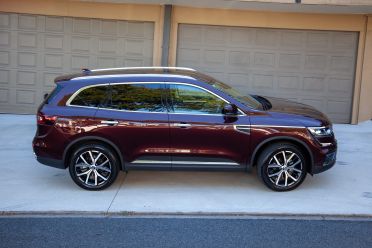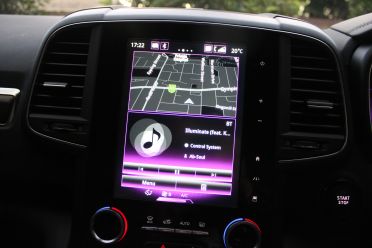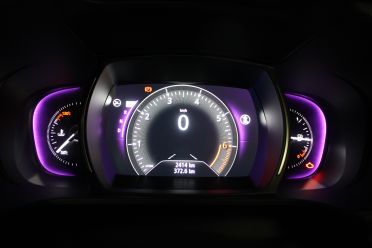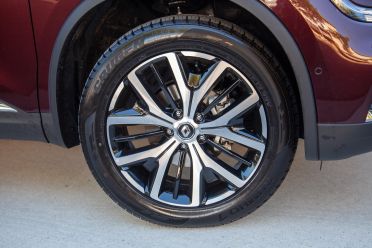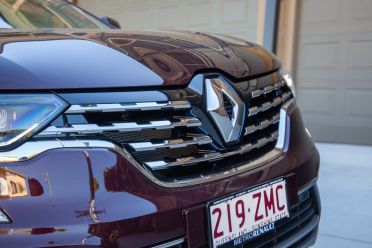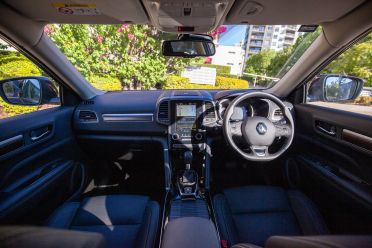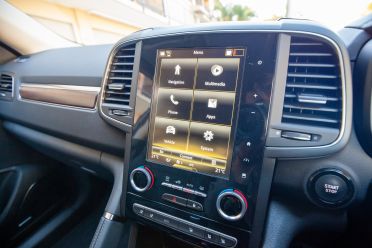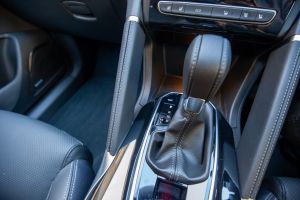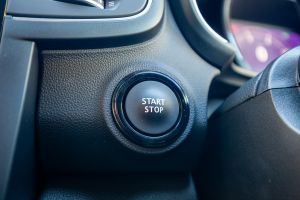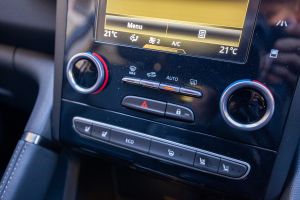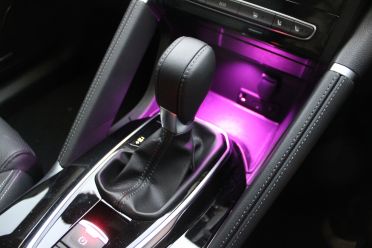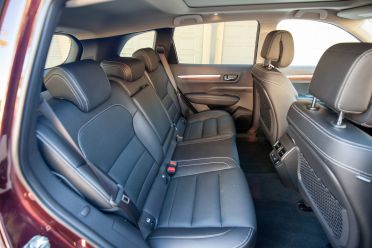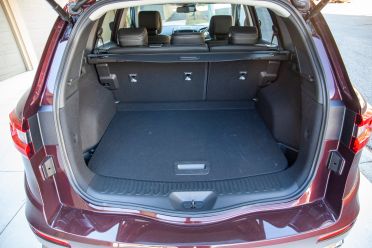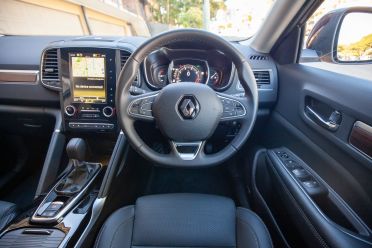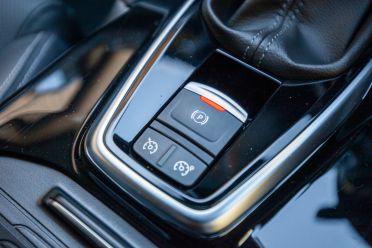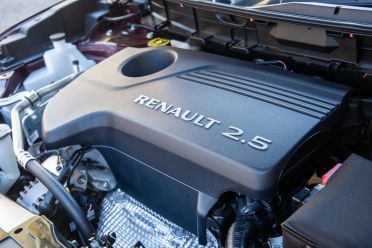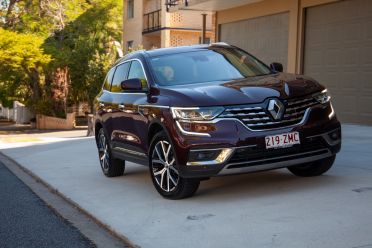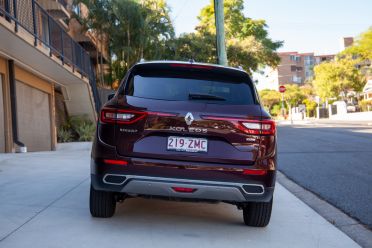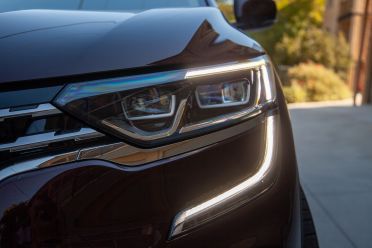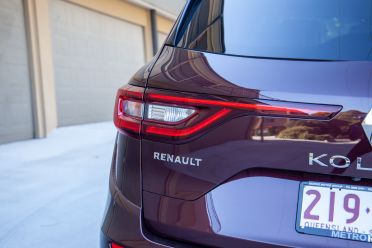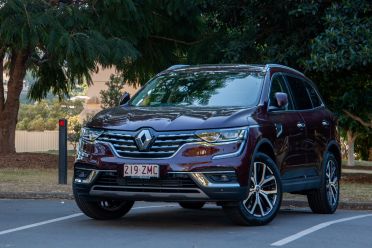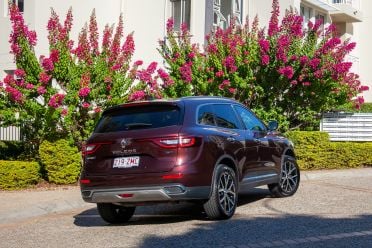While Peugeot struggles to gain traction in Australia and Citroen is lost in the weeds, Renault stands tall as Australia’s favourite French car brand.
The company has the same number of SUVs as Peugeot and actually has fewer cars, and yet Renault outsells its fellow countryman by more than three-to-one.
Mind you, Renault has a popular van range and yet is still outsold significantly by every mainstream Japanese brand.
Nevertheless, it begs the question: is Renault crossing over from quirky to mainstream? To find out, let’s look at what’s arguably its most mainstream offering as well as its most popular – the Renault Koleos mid-sized SUV.

How much does the Renault Koleos Intens 4×4 cost?
The Koleos is priced similarly to rivals like the Hyundai Tucson and Kia Sportage, with the entry-level Life auto starting at $32,490 before on-road costs. That’s just $350 more than the base Hyundai Tucson Active equipped with an auto.
The Renault Koleos has something else in common with those two rivals: its country of origin.
Yes, this European has mixed heritage. Sold as the Renault-Samsung QM6 in South Korea, where it’s manufactured, the Koleos uses the same platform, engine and transmission as the Nissan X-Trail. Intriguingly, it also undercuts the cheapest automatic version of its Japanese-built cousin by $1400.
Our tester is the flagship Intens, the only Renault Koleos available in Australia with all-wheel drive. Equipped as such, it costs $46,290 before on-road costs. That’s $950 more than the most expensive petrol X-Trail, the Ti AWD, but the equipment lists don’t quite match up.
By the way, that gorgeous burgundy paint colour is called Millesim Red and it’s an $880 option, like all the other available metallic paint shades.
What do you get?
Inside, the Intens looks quite different from the Life and Zen.
The regular 7.0-inch touchscreen is replaced with a portrait-oriented, 8.7-inch unit, featuring Android Auto, Apple CarPlay and satellite navigation.
There are plenty of luxury mod-cons to keep the playing field even with the Sportage GT-Line and Tucson Highlander. These include adjustable ambient lighting, a panoramic sunroof, a Bose 11-speaker premium sound system, along with heated, ventilated and power-adjustable front seats.
There are also convenience features like an automated parking system and a power tailgate.
Externally, you can distinguish the Intens from its lesser siblings by its LED headlights and 19-inch alloy wheels.
These features are in addition to those found on cheaper Koleos models, such as dual-zone climate control, rain-sensing wipers, a reversing camera with front and rear parking sensors, an electronic parking brake, and proximity entry with push-button start.
There are some peculiar omissions from this range-topper, however. There’s no adaptive cruise control, for example, nor is there lane-keeping assist or rear cross-traffic alert. You’ll find all of these features on the X-Trail Ti as well as the rival Koreans.
Is the Renault Koleos Intens 4×4 safe?
Though it’s missing some active safety features, there’s still autonomous emergency braking with forward-collision warning, lane-departure warning and blind-spot monitoring.
The camera and radar-based AEB system works at both city and highway speeds, while there’s also pedestrian detection at speeds of up to 60km/h.
All Renault Koleos models come standard with the expected complement of front, front-side and curtain airbags plus anti-lock brakes.
When ANCAP tested the Koleos in 2017, it awarded a rating of five stars.
That rating was based on an adult occupant protection score of 84 per cent, child occupant protection score of 79 per cent, vulnerable road user protection score of 62 per cent and a safety assist score of 52 per cent.
What is the Renault Koleos Intens 4×4 like on the inside?
The Koleos has a classy, modern cabin.
Material quality isn’t necessarily any better than rivals like the Sportage – soft-touch plastics on the top half of the dash, hard ones on the lower – but the presentation is slick. A lot of that comes down to the focal point of the dashboard – the infotainment system.
Renault’s R-Link 2 system is intriguing. Like a Tesla Model S or the upcoming redesigned Ram, its 8.7-inch touchscreen is oriented portrait-style.
That gives it a smartphone-type appearance, with the menu consisting of large, block-like buttons. There’s also a home screen you can customise, while many of the functions you would typically find in a gauge cluster-mounted trip computer – such as fuel economy and tyre pressure – are accessible via the screen.
When you put the Renault Koleos into reverse, the screen splits into a reversing camera image and a sensor map of the car. That’s handy, though the reversing camera image appears a touch small due to the portrait orientation of the screen.
There are a handful of buttons to the side of the touchscreen that control functions like the stereo volume. They aren’t physical buttons and aren’t touch capacitive either, which makes them trickier to handle when you’re on the move.
Unfortunately, there are no redundant buttons on the centre stack for functions as simple as changing your audio source. To do that, you’ll need to click on one of the blocks and then another block, then make a selection.
There’s a voice input function that works reasonably well, though you can’t use it to dictate addresses for the navigation – at least not in Australia. The picture that appears on the screen for the voice assistant also looks suspiciously like HAL 9000.
Climate functions are controllable via buttons and knobs below the touchscreen. These knobs are perhaps the only overtly cheap-feeling items in the interior.
Below the climate controls and the buttons for the heated and ventilated front seats, there’s a little shelf. In front of this are two functional grab handles with stitching details on them. They’re not really necessary and you’ll find they’re quite hard when you inevitably rest your knee against them.
The Intens’ ambient lighting is slick. Like almost everything else, you can adjust it via the infotainment system. There are five colours available, and selecting one will also change the colour used on the gauge cluster and infotainment system.
The ambient lighting elements can be found at the base of the centre stack and on the little strip of metal-look trim above the woodgrain trim on the doors. The door trim lighting is particularly trippy, as it looks like the light is shining through the metal trim.
In the back, you’ll find two USB outlets, a power outlet and an AUX input at the base of the centre console, plus air vents. You’ll also find plenty of legroom but the panoramic sunroof intrudes significantly on headroom.
For the little ones, there are three top tether and two Isofix child seat anchor points.
The powered, hands-free tailgate opens to a 458L cargo area. Volume increases to 1690L with the rear seats folded, surpassing the cargo areas of the Sportage and Tucson.
I also learned there’s plenty of room for two people if you want to back into a space at a drive-in theatre, however the seats don’t fold entirely flat. Almost, though.
Unfortunately, being a French car there just has to be a couple of insufferable quirks. These are centred around the steering wheel controls.
The cruise control switchgear, for example, features an up and down toggle and two buttons labelled “R” and “O”. That’s it.
To actually activate the cruise control, you have to press a button near the gearshift.
The steering wheel cruise control buttons are located where you might usually expect to see audio controls, which are instead located on a pod sticking out from the steering column.
There’s absolutely nothing intuitive about this arrangement. You need to look at the pod at least once to familiarise yourself with what’s on it, something that’s hard to do when it’s behind the steering wheel.
I eventually memorised which buttons to reach for to adjust volume, but the other functions on the pod remained a mystery to me.
The front cupholders are quirky without being insufferable. The recess is split into four segments: two for normal-sized cups and bottles and two smaller ones for perhaps Yakults.
What’s under the bonnet?
Following Renault’s discontinuation of the 2.0-litre turbo-diesel four-cylinder engine from the local Koleos range last year, there’s only one powertrain available.
It’s a naturally-aspirated 2.5-litre four-cylinder petrol engine producing 126kW and 226Nm, mated to a continuously-variable transmission. It powers the front wheels in all Koleos models, though the Intens is available with all-wheel drive. Our tester came so equipped.
How does the Renault Koleos Intens 4×4 drive?
Uncommunicative steering is the automotive equivalent of a limp handshake. It simply doesn’t inspire confidence.
The Koleos’ steering is feather-light. While that might appear a good thing for some drivers, it has the unintended consequence of making the Koleos feel vague and cumbersome to drive.
This mid-size SUV feels hard to place, and there’s also no way to at least add some artificial weight to the steering via a selectable drive mode as in some rivals.
The brakes, too, could use a bit more bite.
It’s a shame as the rest of the Koleos’ dynamic package stacks up well against rivals.
The ride, for example, is compliant. It’s a bit firm but it’s never uncomfortable and it smooths out all but the harshest of bumps and ruts.
The Koleos mightn’t be fast but nor is it overly sluggish, with Renault quoting a 0-100km/h sprint of 9.8 seconds.
Once you get up to highway speeds, engine and road noise is well controlled. Only wind noise around the large exterior mirrors takes the shine off the Koleos’ highway cruising abilities. That wind noise can also be noticed at lower speeds, too.
Less noticeable but nevertheless a concern was a slight rattle coming from the panoramic sunroof.
It wasn’t persistent, however, and the Koleos wouldn’t be the first car to have a panoramic sunroof rattle but it’s worth pointing out.
The Koleos makes a bit of noise when it’s revved but it sounds better than many other rival four-cylinder SUVs. It sounds ever so slightly sporty, at least for a car with a CVT.
The Koleos’ CVT is a competent transmission. If you don’t like CVTs, it probably won’t win you over but it delivers power smoothly and without uncouth droning. There’s a manual shift mode with artificially-stepped gears but you’ll have to move the gearshift as there are no paddle shifters.
You can use the drive mode selector to the right of the steering wheel to toggle between two-wheel drive, four-wheel drive auto, or four-wheel drive lock.
We just left it in four-wheel drive auto, which is ideal for general use. Four-wheel drive lock is designed for use only in severe conditions.
There’s one other annoying quirk to the interior: you’ll need to look at the instrument cluster to check what gear you’re moving the shifter into, as Renault has left the markings on the passenger’s side of the shifter.
Kudos to Renault, though, for picking a sound for its lane-departure warning that’s reminiscent of an audible lane marking, instead of a cacophony of beeps that makes the car sound like a downed helicopter and alarms passengers.
The sound will cut into the stereo, as will other alerts such as the school zone warning. That system isn’t the cleverest, the Koleos warning me I was entering a school zone as I drove along a motorway.
Oh well, at least she said it with a classy accent. We turned that feature off, though.
There was one sound I could have done without, which drove me mad, Telltale Heart-style. A ding sounded every time I drove the car but I couldn’t see any kind of corresponding notification in the gauge cluster or on the touchscreen.
After fruitlessly searching in the settings menus, I just turned the warning alert sounds down, only for the absence of a sound to cut into my music.
After poring through the owner’s manual one night, I discovered it was the speed warning. If there was a visual notification, we missed it. Frankly, any alert system that doesn’t clearly identify what it’s alerting isn’t a good system.
In a mix of city and highway driving, we averaged 9.0L/100km. That was quite close to Renault’s claim of 8.3L/100km on the combined cycle. The Koleos also happily runs on 91RON regular unleaded fuel.
How much does the Renault Koleos Intens 4×4 cost to run?
If you put away a lot of kilometres each year, you’ll appreciate the generous service intervals. The Koleos requires a visit to the dealer every 12 months or 30,000km – that mileage figure is double that of almost every rival.
Renault offers both a five-year, unlimited kilometre warranty and five years of capped price servicing. Each service costs $429 except for the 48 month/120,000km service, which costs $999.
CarExpert’s take on the Renault Koleos Intens 4×4
Set aside a few bits of unintuitive switchgear and the Koleos is, despite the Renault badge, decidedly un-quirky. That’s understandable as, underneath, it shares a considerable amount with the Nissan X-Trail.
It’s a big step up from its corporate cousin in terms of infotainment, however, and its interior presentation is classy and contemporary.
Nevertheless, the mid-size SUV segment is a hugely competitive one and the Koleos doesn’t particularly move the needle or offer anything drastically different.
The feel-free steering and lack of adaptive cruise and lane-keeping assist are also notable demerits.
Still, the Renault Koleos is so thoroughly competent in almost every area that if you’re putting cars like the X-Trail and Tucson on your shortlist, the Renault is worth a look, too.





